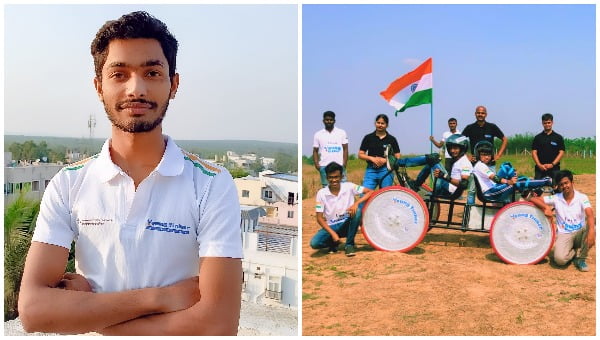From Being A Mechanic To Winner Of NASA Contest: Here’s Odisha Youth’s Tale Of Innovation [Watch]

Bhubaneswar: When the COVID-19 pandemic hit the world, 20-year-old Kailash Chandra Barik’s dreams were shattered for a while. Like everything else, the physical classes at Skill Development Institute in Odisha’s Bhubaneswar were suspended. Barik was pursuing an advanced course in welding at the institute. He returned to his village in Baripada in Odisha’s Mayurbhanj from Bhubaneswar. And, he started working as a mechanic in his father’s bi-cycle repairing garage.
Little did he know that he would soon work on a project for a Nasa contest until he came across an application of an online platform—Young Tinker Website—that enables students to innovate.
The application was a call for being a part of a team that would represent the country at NASA Human Exploration Rover Challenge 2021. “A friend had informed me about the contest and the institute in Bhubaneswar that was looking for participants. I always had the zeal to accept challenges for making a difference. Financial difficulties were a part of reality. But, what’s life, if you don’t dare to take a chance?” he said.
From among several entries, Barik made it to a 10-member team of the academy that came together for the NASA challenge under the guidance of Anil Pradhan —an engineer and mission director of the Navonmesh Prasar Student Astronomy Team (NaPSAT), who grooms scientific temper, develops innovative ideas and nurtures creativity that would have otherwise been lost due to poverty and ignorance.
Kailash wasn’t confident how he would contribute to the making of a prototype for a rover that could be launched on the surface of the moon. “But, I had faith in my welding skills. I knew elementary science that was taught in my high school in Mayurbhanj. Also, I trusted the knowledge I gained at the Industrial Training Institute. However, I had no knowledge about space exploration,” he said.
Kailash wasn’t an amateur alone. All the other members were as clueless as he was. In his team, there were dropouts who had quit higher studies to eke out a living by working as mechanics in garages and welding shops.
For about six to seven months, Kailash dedicated all his days and nights to develop the working model of the rover, which is foldable with no motor and able to fit in 5x5x5 feet space, along with other team members—working remotely. The challenge was to engage the axle, wheels, drive-train, steering, suspension, seat ergonomics, soil extractor and other aspects of the vehicle during the competition.
“We were given a kit by the mentoring institute. With the help of the online training, we slowly and gradually started working on the project from our homes,” he said.
After the restrictions in view of the pandemic were relaxed a bit, the team met physically and their work picked up the pace. From spare parts of bicycles and two-wheelers—collected from various junkyards—the rover was finally made and ready to roll!
Kailash’s team stood third in the high school division of the annual contest after Parish Episcopal School Team 1, Dallas, Texas, and Stillwater Area High School, Stillwater, Minnesota. It was for the first time that an Indian high school team was declared as ‘overall winner’ in the NASA contest. The rover, they created, could move on the surface of both Mars and Moon, carrying two persons.
Since then, there has been no looking back for Kailash. He is now working as a product developer at the academy. He is learning himself as well as helping other children from improvised backgrounds to innovate. At Tinker Academy, he is involved in developing humanoids, robots, satellites, among other things. At present, he is working to develop a car that can measure distance and a satellite with the ability to measure humidity in the atmosphere.
Watch the video here:

Comments are closed.